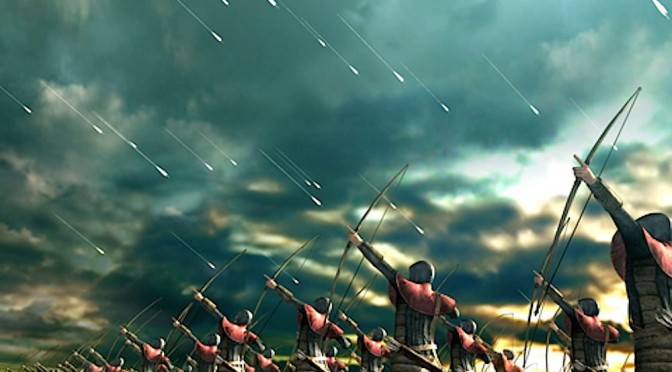Overview
The “Hundred Years War” lasted from 1150 to 1450, which would make it the “Three Hundred Years War” It was this war which decided the fate of Occitan because at the onset the Ramnulfid’s, Dukes of Aquitaine and subsequently calling themselves the Plantagenets had a tenuous hold the lands of Occitan. It was a hold they could and should have consolidated. In fact they relinquished control to the Franks and thereby unleashed the terror of the Albigensian Crusade.
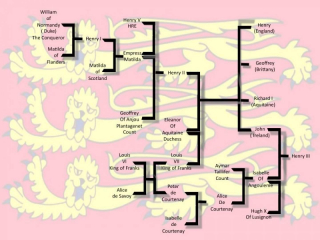
The Start of the Conflict
The conflict started just after Eleanor of Aquitane divorced the Frankish King Louis VII and married Henry son of Geoffrey,Count of Anjou. This union meant that the newly married couple had far greater territories, and therefore sources of revenue than Louis had himself.
It is not surprising that the transfer of affection of this beautiful, spirited woman should have sparked a conflict. but the initiaon point was political not emotional.
At the time, in England an interminable civil war between King Steven and Henry’s mother Matilda spilled over into both Scotland and Wales. The relationship between Matilda and Steven is reputed to have been “unusual”. At various periods in the war Steven captured Matilda and kept her in prison at others Matilda captured Steven. What happened during these periods of imprisonment is open to debate. There are suggestions that Henry was not Geoffrey’s son at all but Steven’s.
In 1150 Matilda made her son Duke of Normandy, a Duchy nominally a possession of the English Crown. Steven protested to Louis and Louis attacked Henry. The result was that Henry yielded and swore allegiance to Louis for Normandy. Steven aquiesced
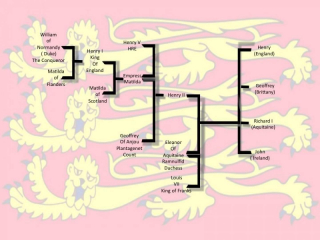
The Plantagenet Empire
This was however a minor setback, Steven accepted Henry as his adopted son and made him heir to the throne of England. This was a very unusual decision as Steven had two sons of his own. It is this act that leads to speclation about Henry’s parentage.
After Steven’s death Henry took firm control of England and of his Southern Empire. He forced Louis to acknowedge his possessions on the mainland, including Toulouse and therefore the vast majority of Occitan. For a brief period Raymond V ( St Gilles)of Toulouse accepted this arrangement and Henry’s daughter Joan was betrothed and subsequently married to the heir to Toulouse , Raimond VI St Gilles.
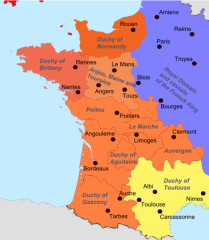
Plantagenet Chaos
Henry and Eleanor had four sons and the succession planning proposed a subdivision of the Plantagenet Kingdom. The eldest soon Henry was proposed as King of England and Duke of Normandy, the second son Richard ( the Lionheart) as Duke of Aquitaine and Anjou, the third son as Duke of Brittany and the youngest son John as King of Ireland. The four sons warred against each other and against their father.
Many supporters were appalled at this Plantagent chaos and switched their allegiance to the Franks. It was at this time that St Gilles family again switch allegiance directly to the Franks, perhaps anticipating a Dukedom. Under the influence of Richard the Lion Heart the Trencavel’s previously part of the St Gilles feudal realm, switched allegiance for the southern part of their possessions to Aragon. The destabilisation of Occitan was complete.
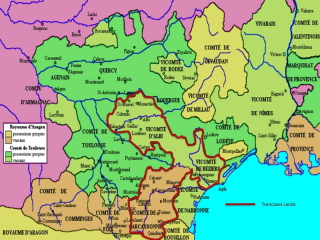
Arthur Eliminated
Worse was to follow. John outlasted all his brothers. The son of his elder brother, Geoffrey had a better claim to the throne, but John swept Arthur to one side and ultimately Arthur disappeared whilst in John’s custody. John managed to further alienate his subjects in Normandy and Anjou because in the course of the brief war against Arthur he failed to adequately reward his strongest supporters and imprisoned and starved to death anyone who dared to oppose him.
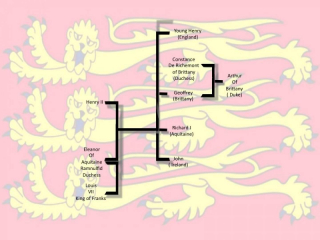
Isabelle Abducted
Then came Isabelle of Angouleme. Isabelle was only thirteen years of age and was engaged to be married to Hugh IX of Lusignon. John stole her away. Wether she was complicit in the abduction is uncertain, as she proved herself to be a very ambitious woman. Regardless the Lusignons transferred their allegiance to the Franks and further weakened John’s position.
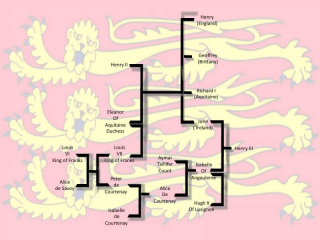
The Albigensian Crusade
For Occitan the all important year was 1209. Two years previously John had confiscated the earldom of Leicester and the revenues of its estates , from Simon de Montfort (the Elder) searching for income to replace what he had lost, Simon joined and ultimately lead the Albigensian Crusade. It is just possible that in an attempt to secure his inheritance Simon, swore allegiance to John. John may have assumed that Simon would capture the territories of Toulouse and the Trencavel and return them to Plantagenet Control. If so he was sorely disappointed. Simon did appropriate the territories but swore in swift succession an allegiance to Aragon (for the Trencavel lands) and then transferred his allegiance to the Franks when Pedro of Aragon objected to his appropriating the St Gilles lands.
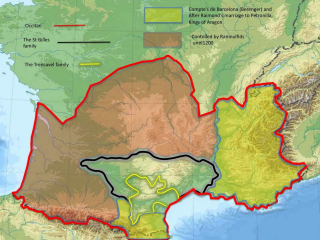
The Battle of Beauvines
As soon it was obvious that John would get no benefit from the Crusade, John made an alliance with the Holy Roman Emperor, Otto. The plan was for Otto to attack the Franks from the north east whilst John attacked from the south west. The co-ordination of the two attacks was poor and Frankish King (Phillip II) manged to hold John in the south in February and then dash north to deal with Otto in March. The southern campaign was inconclusive, but in the North East the Franks won an outstanding victory over the allies at Bouvines. Louis then proceeded to overrun an almost undefended Normandy and Anjou. Any intention John may have had to intervene in Occitan was thwarted
Simon de Monfort was killed whilst laying siege to Toulouse in AD 1218. The St Gilles Family and the Trencavels then sized the initiative expelling Simon de Montfort’ son Aumery . It was a short lived recovery. From 1226 to 1229 the Frankish armies returned to Occitan and reduced it to desert. They did not fight ,they simply destroyed. they burned crops, chopped down orchards olive groves, destroyed silk fans, uprooted vineyards and poisoned wells.
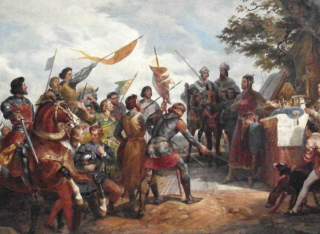
Frankish Gains
The balance of power initially stayed with the Franks, who by the time of Ximene’s birth seemed likely to eject their rivals from the mainland. Most of the gains were achieved not by conquest but by shifting alliances. It was in the middle of this conflict that the Plantagenets began to identify themselves as English and the Valois Franks began to identify themselves as French.
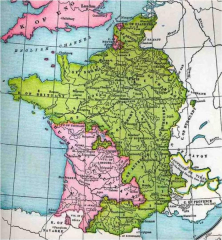
The Chevauchee
In the early 14th century under King Edward III the English began to reassert themselves. At the battle of Crecy , English and Welsh archers annihilated the French cavalry and with it the core of the French aristocracy. At the Battle of Poitiers the French army was routed and their King, John II captured.
In the period between these two battles came the most mysterious episode of the whole war. King Edwards son, the Black Prince invaded Occitan. There are many different versions of what his objectives were and even the timing is uncertain. The Libraries of many towns along the Garronnee and the Aude rivers record a visit which is not recorded in the accepted histories. Some records say he invaded in June others say it was as late as October. it is as if he made two journeys.
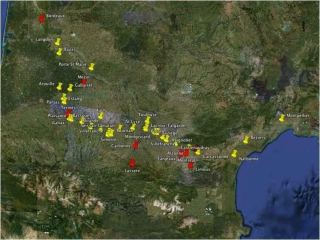
More Feudal Instability
During Ximene’s lifetime the balance swung again until in 1429 King Henry VI of England was accepted as heir to the throne of France. The switch to concepts of nation hood favoured the french more than the English however. The English themselves, encouraged by the publication of alternative histories which gave increased prominence to British and Anglo Saxon history found it easy to accept but it gave encouragement to Scottish, Welsh, Irish and Gascons to see themselves as something different. In contrast it was easier for the French to sell the idea that between the Channel and the Mediterranean or the Pyrenees, between the Atlantic and the Rhine or the Alps lies a single nation. Thus by the time of Joan of Arc’s emergence in 1429 she thought of herself as French and that her divine task was to expel the English. It was obviously a powerful concept.
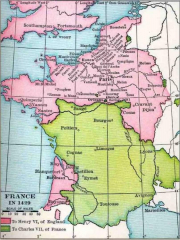
The Conflict started just after Eleanor of Aquitane divorced the Frankish King Louis VII and married Henry, son of Geoffrey,Count of Anjou. This union meant that the newly married couple had far greater territories, and therefore sources of revenue, than Louis had himself.
It is perhaps enough that the transfer of affection of this beautiful, spirited woman should have sparked the conflict, but the initiation point was political not emotional.
At the time, in England there was an interminable civil war between King Steven and Henry’s mother Matilda which spilled over into both Scotland and Wales. The relationship between Matilda and Steven is reputed to have been “unusual”. At various periods in the war Steven captured Matilda and kept her in prison; at others Matilda captured Steven. What happened during these periods of imprisonment is open to debate. There are suggestions that Henry was not Geoffrey’s son at all but Steven’s.
In 1150 Matilda made her son Duke of Normandy, nominally a possession of the English Crown. Steven protested to Louis and Louis attacked Henry. The result was that Henry yielded and swore allegiance to Louis for Normandy. Steven acquiesced.
This was however a minor setback, Steven accepted Henry as his adopted son and made him heir to the throne of England. This was a very unusual decision as he had two sons of his own. It is this act that leads to speclation about Henry’s parentage.
After Steven’s death Henry took firm control of England and of his Southern Empire. He forced Louis to aknowedge his possessions on the mainland, including Toulouse and therefore the vast majority of Occitan. For a brief period Raymond V ( St Gilles) of Toulouse accepted this arrangement and Henry’s daughter Joan was betrothed and subsequently married to the heir to Toulouse, Raimond VI St Gilles
Henry and Eleanor had four Sons and the succession planning proposed a subdivision of the Plantagenet Kingdom. The eldest soon Henry was proposed as King of England and Duke of Normandy, the second son Richard ( the Lionheart) as Duke of Aquitaine and Anjou, the third son as Duke of Brittany and the youngest son John as King of Ireland. The four sons warred against each other and against their father.
Many supporters were appalled at this Plantagent chaos and switched their allegiance to the Franks. It was at this time that St Gilles family again switched allegiance directly to the Franks, perhaps anticipating a Dukedom. Under the influence of Richard the Lion Heart the Trencavel’s switched allegiance for the southern part of their possessions to Aragon. The Destabilisation of Occitan was complete.
Worse was to follow. John outlasted all his brothers. The son of his elder brother Geoffrey had a better claim to the throne, but John swept Arthur to one side and ultimately Arthur disappeared whilst in John’s custody. John managed to further alienate his subjects in Normandy and Anjou because in the course of the brief war against Arthur he failed to adequately reward his strongest supporters and imprisoned and starved to death anyone who dared to oppose him.
Then came Isabelle of Angouleme. Isabell was only thirteen years of age and was engaged to be married to Hugh IX of Lusignon. John stole her away. Wether she was complicit in the abduction is unsure as she proved herself to be a very ambitious woman, Regardless the Lusignons transferred their allegiance to the Franks and further weakened John’s position.
For Occitan the all important year was 1209. Two years previously John had confiscated the Earldom of Leicester and the revenues of its estates from Simon de Montfort (the Elder). Simon, searching for income to replace what he had lost, joined and ultimately lead the Albigensian Crusade. It is just possible that in an attempt to secure his inheritance, Simon swore allegiance to John. John may have assumed that Simon would capture the territories of Toulouse and Trencavel and return them to Plantagenet control. If so he was sorely disappointed. Simon did appropriate the territories but swore in swift succession an allegiance to Aragon (for the Trencavel lands) and then to the Franks when Pedro of Aragon objected to his appropriating the St Gilles lands.
As soon it was obvious that John would get no benefit from the Crusade, John made an alliance with the Holy Roman Emperor Otto. The plan was for Otto to attack the Franks from the north east whilst John attacked from the south west. The co-ordination of the two attacks was poor and Frankish King (Phillip II) manged to hold John in the south in february and then dash north to deal with Otto in March. The southern campaign was inconclusive, but in the North East the Franks won an outstanding victory over the allies at Bouvines. Louis then proceeded to overrun an almost undefended Normandy and Anjou. Any intention John may have had to intervene in Occitan was thwarted
Simon de Monfort was killed whilst laying siege to Toulouse in AD 1218. The St Gilles Family and the Trencavels then seized the initiative expelling Aumery de Montfort, Simon’s son . It was a short lived recovery. From 1226 to 1229 the Frankish armies returned to Occitan and reduced it to desert. They did not fight they simply destroyed. they burned crops, chopped down orchards and olive groves, destroyed silk farms, uprooted vineyards and poisoned wells.
The balance of power stayed with the Franks, who by the time of Ximene’s teenage years seemed likely to eject their rivals from the mainland. Most of the gains were achieved not by conquest but by shifting alliances. It was in the middle of this conflict that the Plantagenets began to identify themselves as English and the Valois began to identify themselves as French.
In the early 14th century under King Edward III the English began to reassert themselves. At the battle of Crecy , English and Welsh archers annihilated The fench cavalry and with it the french aristocracy. At the Battle of Poitiers the French army was routed and their King John II captured.
In the period between, the most mysterious episode of the whole war. King Edwards son, the Black Prince invaded Occitan. There are many different versions of what his objectives were and even the timing is uncertain. The libraries of many towns along the Garronnee and the Aude rivers record a visit which is not recorded in the accepted histories. Some records say he invaded in June others say it was as late as October. It is as if he made two journeys.
During Ximene’s lifetime the balance swung again until in 1429 King Henry VI of England was accepted as heir to the throne of France. The switch to concepts of nationhood favoured the French Rather than the English. The English themselves, encouraged by the publication of alternative histories which gave increased prominence to British and Anglo Saxon records found it easy to see themselves as english but it gave encouragement to Scottish, Welsh, Irish and Gascons to see themselves as something different. In contrast it was easier for the French to sell the idea that between the Channel and the Mediterranean or the Pyrenees, between the Atlantic and the Rhine or the Alps lies a single nation. Thus by the time of Joan of Arc’s emergence in 1429 she thought of herself as French and that her divine task was to expel the English.It was obviously a powerful concept.
